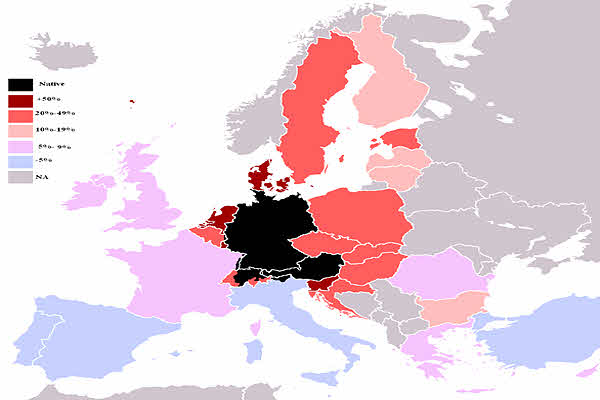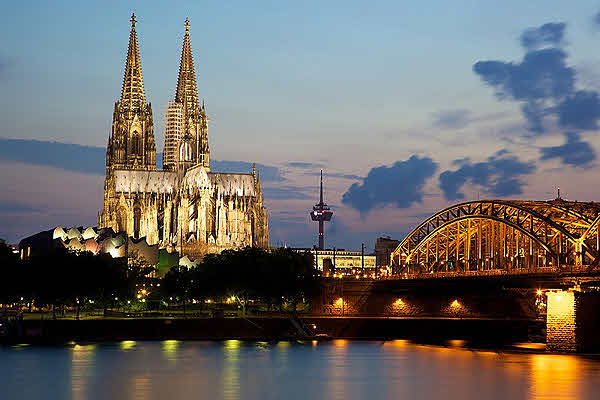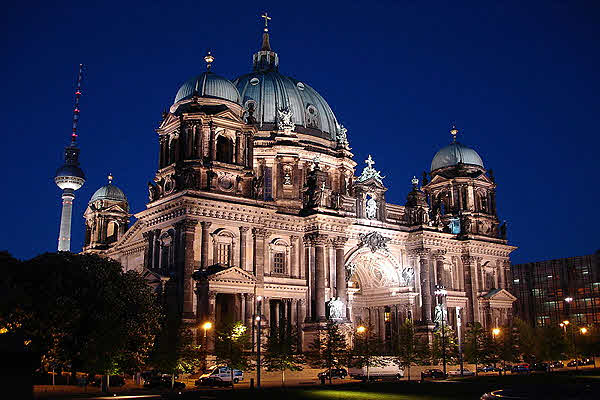Languages

The German language is the most widely-spoken first language in the European Union, with around 100 million native speakers. German is the official and predominant spoken language in Germany. It is one of 23 official languages in the European Union, and one of the three working languages of the European Commission. Recognized native minority languages in Germany are Danish, Low German, Sorbian, Romany, and Frisian; they are officially protected by the European Charter for Regional or Minority Languages. The most used immigrant languages are Turkish, Kurdish, Polish, the Balkan languages, and Russian. 67% of German citizens claim to be able to communicate in at least one foreign language and 27% in at least two languages other than their own.
Standard German is a West Germanic language and is closely related to and classified alongside English, Low German, Dutch, and the Frisian languages. To a lesser extent, it is also related to the East (extinct) and North Germanic languages. Most German vocabulary is derived from the Germanic branch of the Indo-European language family. Significant minorities of words are derived from Latin and Greek, with a smaller amount from French and most recently English (known as Denglisch). German is written using the Latin alphabet. German dialects, traditional local varieties traced back to the Germanic tribes, are distinguished from varieties of standard German by their lexicon, phonology, and syntax.
Religion

The catholic Cologne Cathedral at the Rhine River is a UNESCO World Heritage Site. It is Germany’s most visited landmark
Christianity is the largest religion in Germany, with around 51.5 million adherents (62.8%) in 2008. Relative to the whole population, 30.0% of Germans are Catholics, 29.9% are Protestants belonging to the Evangelical Church in Germany (EKD), and the remaining Christians belong to smaller denominations each with less than 0.5% of the German population. Protestantism is concentrated in the north and east and Roman Catholicism is concentrated in the south and west; 1.6% of the country’s overall population declare themselves Orthodox Christians.
The second largest religion is Islam with an estimated 3.8 to 4.3 million adherents (4.6% to 5.2%), followed by Buddhism with 250,000 and Judaism with around 200,000 adherents (0.3%); Hinduism has some 90,000 adherents (0.1%). All other religious communities in Germany have fewer than 50,000 adherents. Of the roughly 4 million Muslims, most are Sunnis and Alevites from Turkey, but there are a small number of Shiites and other denominations. German Muslims, a large portion of who are of Turkish origin, lack full official state recognition of their religious community. Germany has Europe’s third largest Jewish population (after France and the United Kingdom). Approximately 50% of the Buddhists in Germany are Asian immigrants.

Berliner Dom, one of the main evangelical cathedrals in Germany
Germans with no stated religious adherence make up 34.1% of the population and are concentrated in the former East Germany and major metropolitan areas. German reunification in 1990 greatly increased the country’s non-religious population, a legacy of the state atheism of the previously Soviet-controlled East. Christian church membership has decreased in recent decades, particularly among Protestants.
Health

Hospice of the Holy Spirit in Lübeck – one of the world’s oldest social institutions and a precursor to modern hospitals
Germany has the world’s oldest universal health care system, dating back to Bismarck’s social legislation in 1883. Currently the population is covered by a fairly comprehensive health insurance plan provided by statute. Certain groups of people (lifetime officials, self-employed persons, employees with high income) can opt out of the plan and switch to a private insurance contract. Previously, these groups could also choose to do without insurance, but this option was dropped in 2009. According to the World Health Organization, Germany’s health care system was 77% government-funded and 23% privately funded as of 2005[update]. In 2005, Germany spent 11% of its GDP on health care. Germany ranked 20th in the world in life expectancy with 77 years for men and 82 years for women, and it had a very low infant mortality rate (4 per 1,000 live births).
Culture
From its roots, culture in German states has been shaped by major intellectual and popular currents in Europe, both religious and secular. Historically Germany has been called Das Land der Dichter und Denker (“the land of poets and thinkers”), because of the major role its famous writers and philosophers have played in the development of Western thought and culture. The federated states are in charge of the cultural institutions. There are 240 subsidized theatres, hundreds of symphonic orchestras, thousands of museums and over 25,000 libraries spread in Germany. These cultural opportunities are enjoyed by many: there are over 91 million German museum visits every year; annually, 20 million go to theatres and operas; 3.6 million per year listen to the symphonic orchestras. As of 2012 the UNESCO inscribed 37 properties in Germany on the World Heritage List.
Germany has established a high level of gender equality, promotes disability rights, and is legally and socially tolerant towards homosexuals. Gays and lesbians can legally adopt their partner’s biological children, and civil unions have been permitted since 2001. Germany has also changed its attitude towards immigrants; since the mid-1990s, the government and the majority of Germans have begun to acknowledge that controlled immigration should be allowed based on qualification standards. Germany has been named the world’s second most valued nation among 50 countries in 2010. A global opinion poll for the BBC revealed that Germany is recognized for having the most positive influence in the world in 2011, and for being the most positively viewed nation in the world, in 2013.
Art
Numerous German painters have enjoyed international prestige through their work in diverse artistic styles. Albrecht Dürer, Hans Holbein the Younger, Matthias Grünewald and Lucas Cranach the Elder were important artists of the Renaissance, Peter Paul Rubens and Johann Baptist Zimmermann of Baroque, Caspar David Friedrich and Carl Spitzweg of Romanticism, Max Liebermann of Impressionism and Max Ernst of Surrealism.
Several German artist groups formed in the 20th century, such as the November Group or Die Brücke (The Bridge) and Der Blaue Reiter (The Blue Rider) in Expressionism. The New Objectivity arose as a counter-style to it during the Weimar Republic. After WWII, main movements of Neo-expressionism, performance art and Conceptual art evolved, with notable artists such as Joseph Beuys, Gerhard Richter, Jörg Immendorff, HA Schult, Aris Kalaizis, Neo Rauch (New Leipzig School) and Andreas Gursky (photography). Major art exhibitions and festivals in Germany are the documenta, transmediale and Art Cologne.
Architecture

View over Cologne with its famous Cathedral
Architectural contributions from Germany include the Carolingian and Ottonian styles, which were precursors of Romanesque. Brick Gothic in medieval times and Brick Expressionism in modern times are two distinctive styles that developed in Germany. Also in Renaissance and Baroque art, regional and typically German elements evolved (e.g. Weser Renaissance and Dresden Baroque). Germany is especially renowned for its timber frame old towns, with many well-kept examples to be found along the German Timber-Frame Road, leading from the very south of Germany to Northern Germany and its coasts.
When industrialization spread across Europe, Classicism and a distinctive style of historism developed in Germany, sometimes referred to as Gründerzeit style, due to the economical boom years at the end of the 19th century. Resort architecture and Spa architecture are sub-styles that evolved since the 18th century in Germany, with the first modern spas and Seaside resorts of Europe. Many architects formed this era, with Schinkel, Semper, von Gärtner, Schwechten and Lipsius among them. Jugendstil became a dominant architectural style at the turn of the 19th to the 20th century, with a strong influence of the Art Nouveau movement. The Art Deco movement did not gain much influence in Germany, instead the Expressionist architecture spread across the country, with e.g. Höger, Mendelsohn, Böhm and Schumacher being influential architects.
Germany was particularly important in the early modern movement – it is the home of the Bauhaus movement founded by Walter Gropius. And thus Germany is a cradle of modern architecture. Ludwig Mies van der Rohe became one of the world’s most renowned architects in the second half of the 20th century. He conceived of the glass façade skyscraper. Renowned contemporary architects include Hans Kollhoff, Helmut Jahn, Behnisch, Albert Speer Junior, Frei Otto, Oswald Mathias Ungers, Gottfried Böhm, Stephan Braunfels and Anna Heringer.
Literature and philosophy
German literature can be traced back to the middle Ages and the works of writers such as Walther von der Vogelweide and Wolfram von Eschenbach. Well-known German authors include Johann Wolfgang von Goethe, Friedrich Schiller, Gotthold Ephraim Lessing and Theodor Fontane. The collections of folk tales published by the Brothers Grimm popularized German folklore on an international level. Influential authors of the 20th century include Gerhart Hauptmann, Thomas Mann, Hermann Hesse, Heinrich Böll and Günter Grass. German-speaking book publishers produce some 700 million books every year, with about 80,000 titles, nearly 60,000 of them new. Germany comes third in quantity of books published, after the English-speaking book market and the People’s Republic of China. The Frankfurt Book Fair is the most important in the world for international deals and trading, with a tradition spanning over 500 years.
German philosophy is historically significant. Gottfried Leibniz’s contributions to rationalism; the enlightenment philosophy by Immanuel Kant; the establishment of classical German idealism by Johann Gottlieb Fichte, Georg Wilhelm Friedrich Hegel and Friedrich Wilhelm Joseph Schelling; Arthur Schopenhauer’s composition of metaphysical pessimism; the formulation of communist theory by Karl Marx and Friedrich Engels; Friedrich Nietzsche’s development of perspectivism; Gottlob Frege’s contributions to the dawn of analytic philosophy; Martin Heidegger’s works on Being; and the development of the Frankfurt school by Max Horkheimer, Theodor Adorno, Herbert Marcuse and Jürgen Habermas have been particularly influential. In the 21st century, Germany has contributed to the development of contemporary analytic philosophy in continental Europe, along with France, Austria, Switzerland and the Scandinavian countries.
Cuisine
German cuisine varies from region to region. The southern regions of Bavaria and Swabia, for instance, share a culinary culture with Switzerland and Austria. In all regions, meat is often eaten in sausage form. Organic food has gained a market share of ca. 2%, and is expected to increase further. Although wine is becoming more popular in many parts of Germany, the national alcoholic drink is beer. German beer consumption per person is declining, but at 121.4 litres in 2009 it is still among the highest in the world. The Michelin guide has awarded nine restaurants in Germany three stars, the highest designation, while 15 more received two stars. German restaurants have become the world’s second-most decorated after France.
Pork, beef, and poultry are the main varieties of meat consumed in Germany, with pork being the most popular. The average person in Germany will consume up to 61 kg (134 lb) of meat in a year. Among poultry, chicken is most common, although duck, goose, and turkey are also enjoyed. Game meats, especially boar, rabbit, and venison are also widely available all year round. Trout is the most common freshwater fish on the German menu; pike, carp, and European perch also are listed frequently. Vegetables are often used in stews or vegetable soups, but are also served as side dishes. Carrots, turnips, spinach, peas, beans, broccoli and many types of cabbage are very common. A wide variety of cakes and tarts are served throughout the country, most commonly made with fresh fruit. Apples, plums, strawberries, and cherries are used regularly in cakes. Cheesecake is also very popular, often made with quark. Schwarzwälder Kirschtorte (Black Forest cake, made with cherries) is probably the most well-known example of a wide variety of typically German tortes filled with whipped or butter cream.
Sports
Twenty-seven million Germans are members of a sports club and an additional twelve million pursue sports individually. Association football is the most popular sport. With more than 6.3 million official members, the German Football Association (Deutscher Fußball-Bund) is the largest sports organization of its kind worldwide. The Bundesliga, the top league of German football, is the most popular sports league in Germany and attracts the second highest average attendance of any professional sports league in the world. The German national football team won the FIFA World Cup in 1954, 1974 and 1990 and the UEFA European Football Championship in 1972, 1980 and 1996. Germany hosted the FIFA World Cup in 1974 and 2006 and the UEFA European Football Championship in 1988. Among the most well-known footballers are Franz Beckenbauer, Gerd Müller, Jürgen Klinsmann, Lothar Matthäus, and Oliver Kahn. Other popular spectator sports include handball, volleyball, basketball, ice hockey, and tennis.
Germany is one of the leading motor sports countries in the world. Constructors like BMW and Mercedes are prominent manufacturers in motor sport. Additionally, Porsche has won the 24 Hours of Le Mans, an annual endurance race held in France, 16 times, and Audi has won it 11 times. The Formula One driver Michael Schumacher has set many motor sport records during his career, having won more Formula One World Drivers’ Championships and more Formula One races than any other driver; he is one of the highest paid sportsmen in history. Historically, German sportsmen have been successful contenders in the Olympic Games, ranking third in an all-time Olympic Games medal count, combining East and West German medals. In the 2008 Summer Olympics, Germany finished fifth in the medal count, while in the 2006 Winter Olympics they finished first. Germany has hosted the Summer Olympic Games twice, in Berlin in 1936 and in Munich in 1972. The Winter Olympic Games took place in Germany once in 1936 in the twin towns of Garmisch and Partenkirchen.
People
Being a federal republic, Germany is very much a decentralized country, which embraces the cultural differences between the regions. Most travellers will perhaps only think of beer, Lederhosen and Oktoberfest when Germany comes to mind, but Germany’s famous alpine and beer culture is mostly centered on Bavaria and Munich. Here the beer is traditionally served in 1 litre mugs (normally not in pubs and restaurants, though). The annual Oktoberfest is Europe’s most visited festival and the world’s largest fair. Germany’s south-western regions, however, are well known for their wine growing areas (e.g. Rheinhessen and Palatinate) and Bad Dürkheim on the ‘German Wine Route’ (Deutsche Weinstraße) organizes the biggest wine festival worldwide with over 600,000 visitors annually. The fall of the Berlin Wall in 1989 and the subsequent German Reunification are the main events of recent German history. Today most Germans as well as their neighbors support the idea of a peaceful reunified Germany and while the eastern regions still suffer from higher unemployment and of brain drain, the reunification process is overall seen as a success. October 3rd is celebrated as “German Unification Day”.
Cars are a symbol of national pride and social status. Certainly manufacturers such as Audi, BMW, Mercedes, Porsche and Volkswagen (VW) are world famous for their quality, safety and style. This quality is matched by Germany’s excellent network of roadways including the renowned Autobahn network, which has many sections without speed limits that attract speed hungry drivers. There are actually speed tourists who come to Germany just to rent an exotic sports car and fly down the autobahn. Amazingly for its size Germany is home to the third largest freeway/motorway network in the world. Germany also features an extensive network of high speed trains – the Intercity Express (ICE). Most cities have a vibrant gay and lesbian scene, especially Berlin and Cologne. The Berlin tourism agency and other tourism organizations have started campaigns to attract gay and lesbian travellers to their cities. In fact, some politicians (e.g. the mayor of Berlin and the German federal foreign minister) and stars in Germany are homo- or bisexuals. Germany was the host of the FIFA World Cup 2006.
Cities
Germany has numerous cities of interest to travellers; here are just nine of the most famous:
Berlin — the reunified and re-invigorated capital of Germany; known for its division during the Cold War by the Berlin Wall. Today, it’s a metropolis of diversity with elegant clubs, shops, galleries and restaurants
Bremen — one of the most important cities in northern Germany, its old town is a slice of hanseatic history
Cologne — city founded by the Romans 2000 years ago with a huge cathedral, Romanesque churches, and archaeological sites
Dresden — once called ‘Florence on the Elbe’ and world-famous for its Frauenkirche and rebuilt historic centre destroyed during World War II
Düsseldorf — Germany’s capital of fashion also offers fascinating new architecture and a vibrant nightlife
Frankfurt — seat of the European Central Bank (ECB), with a skyline reminiscent of Manhattan (“Mainhattan”)
Hamburg — Germany’s richest and second-largest city, famous for its harbour; liberal and tolerant culture with its nightclubs and casinos along the Reeperbahn
Munich — Bavaria’s beautiful capital city, gateway to the Alps and the site of the famous Oktoberfest
Nuremberg’s old town has been reconstructed, including the Gothic Kaiserburg Castle. Visit the Nazi party rally grounds, the Documentation Centre and Courtroom 600 (the venue of the Nuremberg Trials)
Health care
If you have a non-urgent medical problem, you may choose from any local doctor. The German health system allows specialists to run their own surgery so you usually will be able to find every discipline from Dentistry to Neurology on duty within reasonable reach. In remote regions finding a doctor might require a ride to the next town but the German infrastructure allows fast connections. GPs/family doctors will usually describe themselves as “Allgemeinmediziner” – meaning “general practitioner”.
Health insurance
EU citizens that are members of any public health insurance can get a European Health Insurance Card. The card is issued by your insurance provider and lets you use the public health care system in any EU country, including Germany. If you’re from outside the EU, or if you have a private health insurance, check if your insurance is valid in Germany. If not, get a travel health insurance for the trip – German health care is expensive. Foreign insurance, even if it covers travel abroad, may not be accepted by local hospitals.
